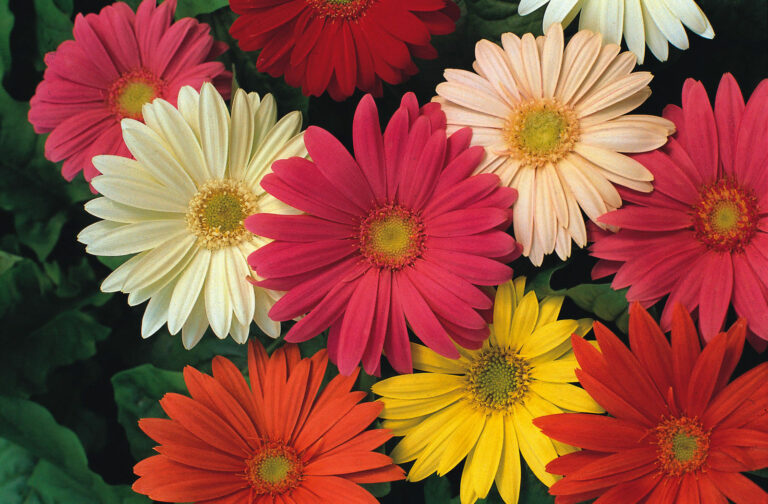If you are looking for a beautiful and easy-to-grow flower to brighten up your garden beds or pots, look no further than Gerbera daisies! Native to South Africa, these beauties are part of the Aster family, just like sunflowers. Today’s Gerbera daisies are the result of hybridization techniques that have created a wide range of stunning colors and shapes. These tender perennials can come back year after year in most parts of the United States, but in cold winter zones without protection, they’re treated as annuals.
Common Gerbera varieties:
- Barberton – This variety has bright red or orange petals with a dark center, making for a striking contrast.
- Pink Surprise – As the name suggests, this Gerbera has beautiful pink petals with a yellow center.
- Dune – Dune Gerberas have soft peach-colored petals with a dark center, adding a touch of warmth to any garden.
- Hawaii – This variety features vibrant yellow petals with a dark center, reminiscent of a sunny day on the beach.
- Sweet Glow – Sweet Glow Gerberas have soft pink petals with a yellow center, giving off a delicate and charming vibe.
Care
Gerbera daisies are a beautiful addition to any garden, and with proper care, they can bloom throughout the summer.
They can be planted in garden beds or containers, and while they are slow to develop from seed, they can also be grown from starts. Deadheading spent blooms and removing clustered center leaves can help the plant continue to bloom and stay healthy. Be mindful of how much water you give the stems, as too much can shorten their display time.
- Soil: use well-draining soil that is rich in organic matter and has a pH level between 5.5 and 6.5. High pH levels may cause yellow stripes on the leaves, while low levels can lead to black spots or patches on the leaves.
- Water: To keep Gerbera daisies healthy, water them regularly with around 1 inch of water per week, making sure the soil has dried an inch or two below the surface before watering again.
- Temperature: These plants thrive in USDA hardiness zones 8 through 11, and need winter protection in zone 8 where they are often grown as annuals. They prefer a cool but not cold winter temperature and have no special humidity needs.
- Light: Gerbera daisies grow best under full sun but not intense heat. It is recommended to plant them in a location that receives afternoon shade if you live in a hot climate and avoid planting them near a structure that reflects heat onto the plant.
Propagation
There are three ways to propagate Gerbera Daisies: from seed, division, or cuttings.
To divide, use a sharp, sterilized knife or pruning snips to cut the root ball into two parts and replant in a new pot with fresh soil.
To propagate from cuttings, take cuttings from the base or side shoots of the plant, dip the cut end in rooting hormone, and plant in well-draining soil. Propagation is best done in the spring or summer when it’s warm, and water the divisions or cuttings thoroughly after planting.
Common Pests
Frequently Asked Questions
While Gerbera daisies can be started indoors from seed, they are best grown outdoors where they can receive ample sunlight and rich soil, so they are not typically grown as long-term indoor plants.
Should I keep my Gerbera daisies in pots or in my garden beds?
To decide between container planting or garden bed planting, consider the type of soil you have and your climate. If you have heavy clay soil or are in a climate zone where Gerbera daisies are not hardy year-round, container planting may be a better option.
Why are my Gerbera daisies drooping?
Drooping Gerbera daisies can be caused by root-bound plants, watering issues such as under-watering or improper drainage, and pH imbalances in the soil. Solutions may include transplanting into larger pots or garden beds, adjusting watering schedules and soil composition, and correcting the pH of the soil.

